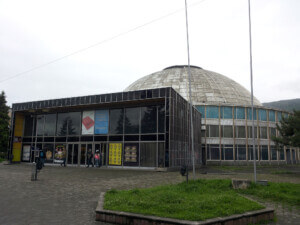This August, as hundreds of wildfires darkened the sky above my home in Corte Madera, California, thousands of miles away in Florida, my family braced for wind and flooding as two hurricanes barreled towards the Gulf of Mexico. We all hunkered down, anxiously, as climate change-fueled disasters wreaked havoc. For weeks, the air quality in California was too hazardous for us to open our windows or go outside. In Pensacola, the Gulf storm surge was several feet deep around my family’s home and the powerful winds downed mature oak trees in their yard.
As architects, we design buildings that are meant to withstand the forces of nature, that will keep people safe and secure during natural disasters. We also design buildings that will connect people with nature and beauty, filled with light, and that circulate fresh air.
The confluence of extreme weather this year has made it clear that our job is getting harder in a climate already altered by carbon pollution. It’s also clear that buildings, despite designers’ considerable efforts to improve efficiency, are still a massive part of the problem, and that we have to do much more to wean our built environment off of fossil fuels.
This means phasing out gas use in buildings as quickly as possible.
The architectural community has long acknowledged that we are at the forefront of the battle against climate change. For years, we have understood that any viable solution to this crisis must adequately address climate pollution from buildings—which are responsible for around 40 percent of the United States’ total greenhouse gas emissions. And for years, our efforts have centered primarily on energy efficiency—designing buildings that consume less energy, and therefore, generate less pollution.
But this year’s unprecedented wildfires, heat waves, and hurricanes have made it overwhelmingly clear that energy efficiency paired with fossil fuels is no longer enough. If we want buildings to aid in our efforts to combat the climate crisis, then it’s time to stop designing buildings with gas—which is now the number one source of climate pollution in the United States.
Numerous studies have shown that transitioning to all-electric homes and buildings, which can run on 100 percent renewable energy, is the lowest-cost, lowest-risk pathway to decarbonizing buildings.
Every time we design a new building with a gas hookup, we are choosing to increase climate pollution and expand our fossil fuel infrastructure, locking ourselves into decades of avoidable climate-warming carbon emissions.
A wave of state-wide policy decisions over the last two years has signaled that lawmakers are waking up to the dangers associated with building with gas—and the future of gas appliances in homes and buildings is likely limited. Four states—Colorado, Massachusetts, New York, and California—have opened up investigations into phasing out their gas distribution systems, and nearly 40 cities in California have passed policies to phase-out gas in new construction. A statewide all-electric building code in California may also be imminent.
By continuing to build with gas, despite clear indications that policymakers are moving to eliminate fossil fuels in homes, we are setting up our clients for expensive retrofits to remove these gas appliances before the end of their service life. While retrofitting homes to remove fossil fuel appliances is costly, building homes that are all-electric from the get-go is actually less expensive and can even lower utility bills for households.
Understanding the benefits of all-electric construction, it’s imperative that as architects, we lead the way towards a healthier, more sustainable future by educating our clients about the climate dangers associated with gas.
Our clients should know that in addition to increasing carbon pollution, gas appliances—especially stoves—also generate toxic indoor air quality inside homes, releasing dangerous levels of nitrogen dioxide pollution. Children living in homes with gas stoves are 42 percent more likely to develop asthma. A literature review conducted by the Rocky Mountain Institute found that homes with gas stoves have levels of NOx pollution that are 50 percent-to-400 percent higher than homes with electric stoves.
For years, the fossil fuel industry has succeeded in fooling the public into thinking that gas appliances are generally clean and safe. In fact, they are filling homes with many of the same pollutants as car exhaust and, meanwhile, are worsening the climate crisis. Our clients should be aware of the dangers.
We’ve known about climate change for decades, and now, scientists’ terrifying predictions are starting to play out. The data is clear: building with gas is incompatible with achieving the deep reductions in pollution necessary to avoid the worst consequences of the climate change crisis.
We need to start listening to the scientists and stop installing new fossil fuel infrastructure in buildings. Here in California, we have a long way to go. We lead the nation in building new fossil fuel buildings. Many states in the Southeast and Northwest have been designing all-electric for many years.
It’s crunch time, and we in the architectural community need to step up. As thought leaders gather at the Greenbuild virtual conference this week, I challenge all of us to meet this moment by rethinking how we power our buildings to eliminate fossil fuels. We must lead the way into a new era of sustainable, healthy, all-electric building. We can eliminate gas, and protect families from the health impacts, just as we eliminated asbestos and lead paint. Don’t try to minimize it or offset it—it’s time to design beyond gas.
Scott Shell is a principal at EHDD Architecture and a member of the American Institute of Architects California Committee on the Environment.











